Loving the Gift of Data; Thank You IBISWorld!
For over a year we have been able to say with confidence that the adoption industry brought in 13 billion dollars in 2013 based on an IBIS World market research report. As I shared the news and information I had found back when I found it, the full report was not something that I could afford at $950 bucks and my attempts at obtaining a full version were in vein, though I never forgot how much I coveted this information.
This am, I went to pull up the original page with the report “snap shot” to share and found, to my delight, that there was a NEW version of the same Adoption & Child Welfare Services Market Research Report with 2014 / 2015 numbers and projections! My lust ( yes, real lust. I am a true research geek.) for this data grew again.
14 BILLION Dollars in Adoption and Child Welfare Revenue!
Tortured again by the tantalizing data just out of my reach, of course I immediate noted that Adoption & Child Welfare Services now are expected to bring in a revenue of 14 Billion Dollars during 2015 and thought that now we would have to retrain ourselves to say 14 billion instead. Still, though, I wanted the full report. However, unlike last year, my single Tweet looking for someone who might have an access account caught the attention of the lovely IBISWorld Twitter account manager who recommend that I email them. AND so after just ONE SINGLE email, saying how much I would love this information and that it might also help with the NYT article on Birthmothers, I was given the full report.
And I preceded to do a happy dance. Literally.
So now, I shall do what must be done with more information; we use the available data and learn more.
New Facts On Revenue and Profits in Adoption
So first, what is now no longer withheld from the “snapshot”:
So the 14.1 billion dollars is the revenue total. Now, the actual profit ( aka money left over after paying the bills) number is broken out as $380,900,000.00. However, to be fair, not ALL of that is actually in the “adoption” bucket.
Breaking Down the Adoption Market
As shown on the chart below, AdoptionLand really doesn’t count in the same markets.
Youth Service Programs include organizations such as Boys & Girls Clubs of America (BGCA) and Big Brothers Big Sisters of America, so we aren’t going to count them in here. Likewise the Youth Counseling and Developmental Services that provide counseling, emergency food and shelter and other resources for youths and families including general skills training and career training for youths through workshops and other programs are also not the same. For the same reasons, Shelter Services and Other Social Assistance Services that are considered a very diverse catchall category are social assistance services for disabled children and self-help group services are also NOT exactly what we are thinking of. So that leaves Foster and Guardianship Services and Adoption. For the most part, it’s easy to break out the numbers.
Check My Math? Profit and Revenue Break Downs
Adoption Services Revenue and Profit Break Down:
So if out of the 14.1 billion is 100% of the revenue, adoption’s 8.2% equals $1,156,200,000.00 in revenue and out of the $380,900,000.00 in profits, adoption’s 8.2% portion results in $31,233,800.00.
Now this “adoption” category does includes both licensed agencies and unlicensed facilitators that arrange adoptions, but does NOT seem to include the attorneys and legal fees.
So REALLY if we want to sound like we know what we are talking about then Adoption services by agencies and facilitators ALONE are supposed to bring in over 30 MILLION dollars in PROFIT in 2015. So while the number is smaller than what we have been saying and a bit less dramatic, it is also NOT the entire industry, at least the way I see it.
Now if we take the ESTIMATED numbers of mothers who relinquish annually, which the last best numbers came for the 2007 Donaldson Report, is between 13 and 15 thousand, and use 14K as a rounded estimate for the number of children relinquished, then we get an ASTOUNDING $82,585.71 in REVENUE PER relinquishment. This number is so much bigger than I had thought… I was thinking we’d see that nice 30to 40K that is considered agency “fees” for an adoption…. that I did this math three times. As in, for every pregnant mother who relinquishes over 80 thousand dollars is brought into the adoption ONLY potion of this industry! That’s ton of INCOME. Now, I will say that we do know that agencies must spend time and recourse on all the moms that do NOT end up relinquishing, so the 14K is only the moms that go through with this course of action, but it shows just HOW much money comes INTO an agency overall. It’s a huge price on one’s head and shows the value of a pregnant women to anyone in the industry.
Of course, the gift of accounting makes it so that expenses minus revenue results in tiny profits, so it’s only a mere $2,230 per baby head in profits. But it is that 82 thousand dollars that keeps the rent, the social workers and directors salaries, the advertising, etc. all paid.
Foster and Guardianship Services Revenue and Profit Break Down:
This industry’s second largest service category, foster and guardianship services are expected to account for 25.4% of revenue in 2015. ” Industry foster care agencies recruit and train caregivers and place foster children in appropriate homes. Foster care agencies may be public or private, for-profit or nonprofit.” Now granted , I will admit that I usually think of foster care services as coming from the government run sector, so I am guessing there is some overlap here into what we think of “adoption” but overall there seems to be a division?
While we see that 397,000 children were in foster care in 2012, the commonly known number is that 100,000 of them are cleared legally to be adopted. I wonder if they really keep track that carefully or if that same child could be represented in more than one market?
Interestingly enough, the report also states that the number of children in foster care has declined over the past five years due to initiatives promoting care by known biological relatives. That is a good thing.
Anyway, here’s the breakdown:
Out of the 14.1 billion is 100% of the revenue, Foster and Guardianship Services ‘s 25.4% equals $3,581,400,000.00 in revenue and out of the $380,900,000.00 in profits, Foster and Guardianship Services ‘s 25.4% portion results in $96,748,600.00.
Now since we know the number of actual children served 397,000; that further breaks down to each child resulting in $9,021.00 in revenue and about $244.00 cleared post expenses for each child. These numbers are gross estimates based on simple math, but it does give a clear picture of what actually seems to me a SMALL amount of money brought in per child.
Now orphanages and group homes are NOT included in this industry segment, so even adding Foster and Adoption together, we are not really getting the full picture. And it is worth noting again, legal fees are NOT in here either. So every adoption attorney who charges a fee and makes a profit is not in here, though I would imagine the legal fees accrued by any agency is counted as part of their expenses.
What Else is in the Market Report?
So there is lots of discussion on how the recession hurt the adoption industry.
“The majority of industry operators receive some portion of their funding through public and private institutional donations, with the remainder collected through service and membership fees. As government spending at the local and state levels stagnated and disposable income inched upward as a result of the recession, industry revenue suffered into the beginning of the current-five year period.”
“Slow disposable income growth made it difficult for many families to afford expensive adoption services, which is estimated to range from $5,000 to $40,000 by the Administration for Children and Families (ACF).”
The government funding died up and there was less disposable income, but both are considered to be increasing so the adoption industry is supposed to continue to improve. The Adoption and Child Welfare Services industry is projected to grow at an annualized rate of 2.2% to $15.7 billion in the five years to 2020. Where’s my party hat?
One threat to the adoption Industry as a whole is the declining poverty rate!
“The poverty rate measures the percentage of the population that is below the federal poverty line. When the poverty rate increases, families have greater difficulty providing for children. Social research has also indicated that poverty is positively correlated with incidences of child abuse. Both of these factors bolster demand for child welfare and adoption services provided by industry operators. In 2015, the poverty rate is expected to fall, representing a potential threat to the industry.”
Boo hoo. But really, it benefits THEM if we are poor?
“Typically, families most in need of services for their children are unable to bid for these services due to their low income and higher probability of being unemployed. Indeed, because the clients of this industry are defined by their poverty, and thus their lack of effective demand, this industry functions primarily as a result of charitable donations”
More Adoption Professionals and MORE Demand for Domestic Infants Predicted
And yes, because there are more: “The number of industry participants, meanwhile, has also grown. Over the five years to 2015, the number of operators is anticipated to increase at an average annual rate of 2.5% to 35,895.”
“Improving profit margins combined with low barriers to entry will provide an incentive for operators to enter this industry. IBISWorld projects the number of operators to grow at an average annual rate of 2.4% to 40,474 over the five years to 2020. However, employment will grow more slowly, as many organizations will rely on volunteer labor to manage wage costs.”
“Profit for for-profit firms has increased over the past five years, thereby boosting margins for the industry as a whole. Industry operators benefited from federal legislation that funded for-profit foster care agencies”
Then there seems to be much like this:
Regulatory changes at the federal level in recent years have initiated a dramatic shift in the industry. Legislative initiatives enacted since 2008 have decreased the foster care population, therefore decreasing the need for this industry’s foster care placement services while increasing the volume of US adoptions and the need for the industry’s adoption services.
Also, we know that decrease in international adoptions has hurt the industry finically for sure:
“Furthermore, international adoptions, which typically have higher placement fees, rapidly fell over the past five years. As a result, demand for adoption services has declined, hampering industry revenue growth. ”
So, we do the good thing and get more kids OUT of foster care, and THAT increases the demand for infant adoption. Less kids (and income) coming from overseas and THAT increases the demand on domestic infant adoptions.
“At the same time, projected increases in average disposable income in the United States will heighten demand for adoption placement services. From 2015 to 2020, IBISWorld anticipates consumer disposable income will increase at an average annual rate of 2.5%. This will permit a greater number of potential adopters to meet federally mandated caretaker criteria. More generally, growth in disposable income will make adoption more financially feasible for parents, increasing adoption services’ share of industry revenue.”
Collecting Adoption Fees
The next following bits I found rather amusing as the report specifies much and Fees. And NOT buying and selling children:
“Children aged 7 years and younger dominate the adoption services segment, as families typically prefer adopting younger children. According to the Administration for Children and Families, children adopted in 2012 (latest available data) had a median age of 5.1 years. As a result of this preference, there is a relatively greater presence of for-profit operators in this market segment. Some private adoption agencies, which collect fees, exclusively focus on placing very young children with prospective families. However, over the past five years, stagnant disposable income made it more difficult for families to afford adoption fees. ( hence, crowd sourcing fundraisers!) International adoption has also declined. Consequently, this market segment’s share of revenue is expected to fall to 47.9% in the five years to 2015.”
“Although children adopted through this industry may be brought into the country from abroad, the fees collected by industry operators reflect reimbursement for legal expenses and the placement service itself. Thus, firms generate revenue by coordinating and providing a service; industry operators do not buy or sell children. ( oh of COURSE not) Due to the service-based nature of this industry’s activities, there is no import or export of goods, and consequently, no international trade. Nonetheless, over the past five years, international adoptions have declined. ”
What has declined? The NUMBERS of Children brought available who are NOT goods to trade, but that’s the number you look at, right?
But hey, it’s all services, right? Yet, the “average wage is comparatively low at an estimated $36,948.” Industry operators on average spend 15.6% of revenue on fundraising initiatives. There is also much about where the government funding comes from though it is a bit repetitive.
So, we have a bit more to go by, but still unanswered questions. The report is a good picture of the industry OVERALL, but still hard to pin point real hard numbers specific to adopting and the real breakdowns. How many kids get relinquished, are adopted, go back and are reunified, get re-homed, what are the step parent adoptions and how do they factor in , what are the legal fees?
However, we can say that Adoption Services alone – not counting legal fees, not counting foster care, is over 30 million dollars in profits projected for 2015.
62411 Adoption & Child Welfare Services in the US Industry Report 2015
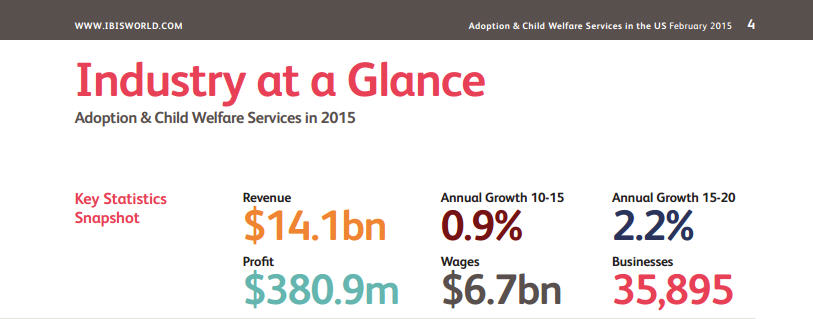
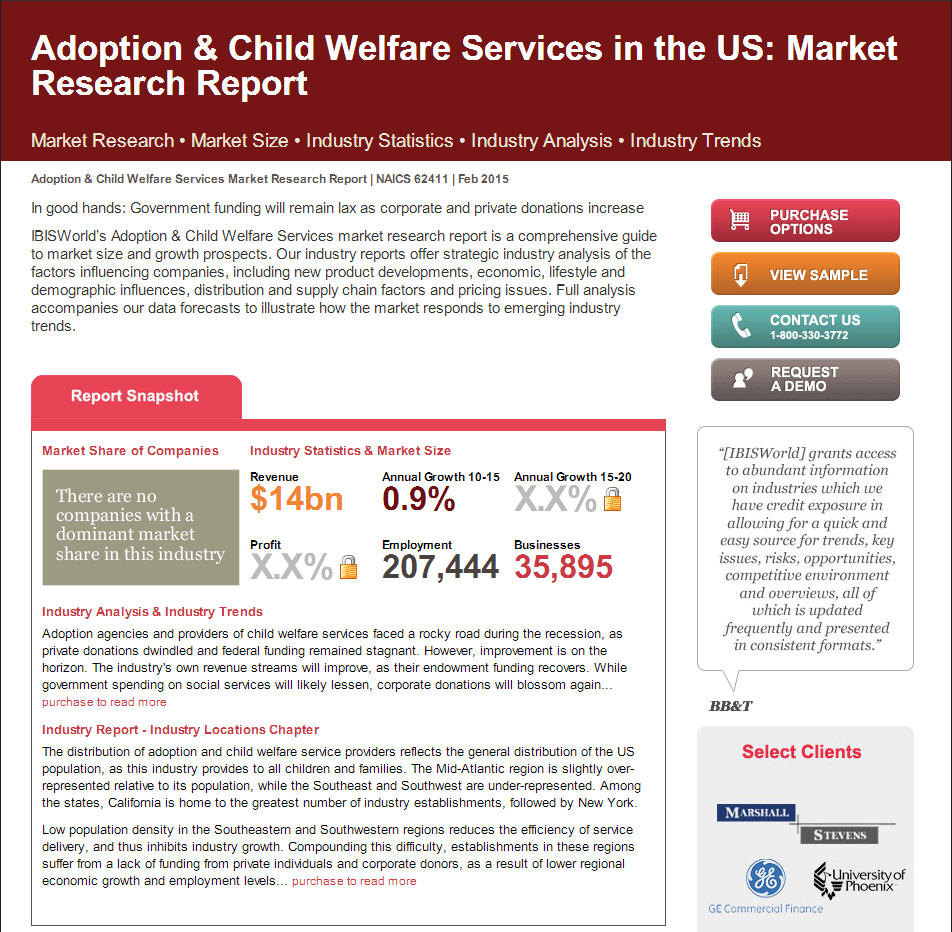

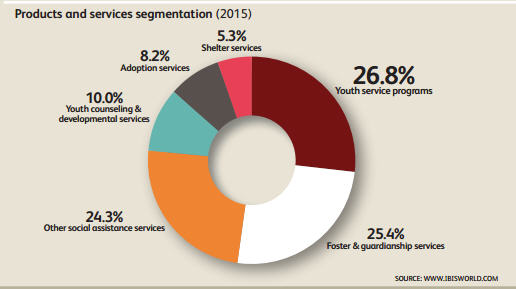


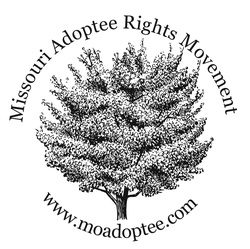
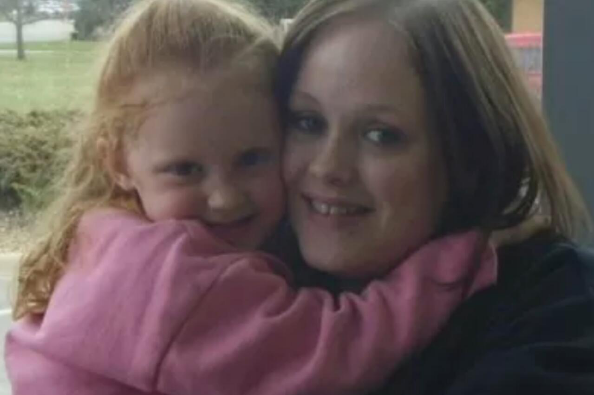
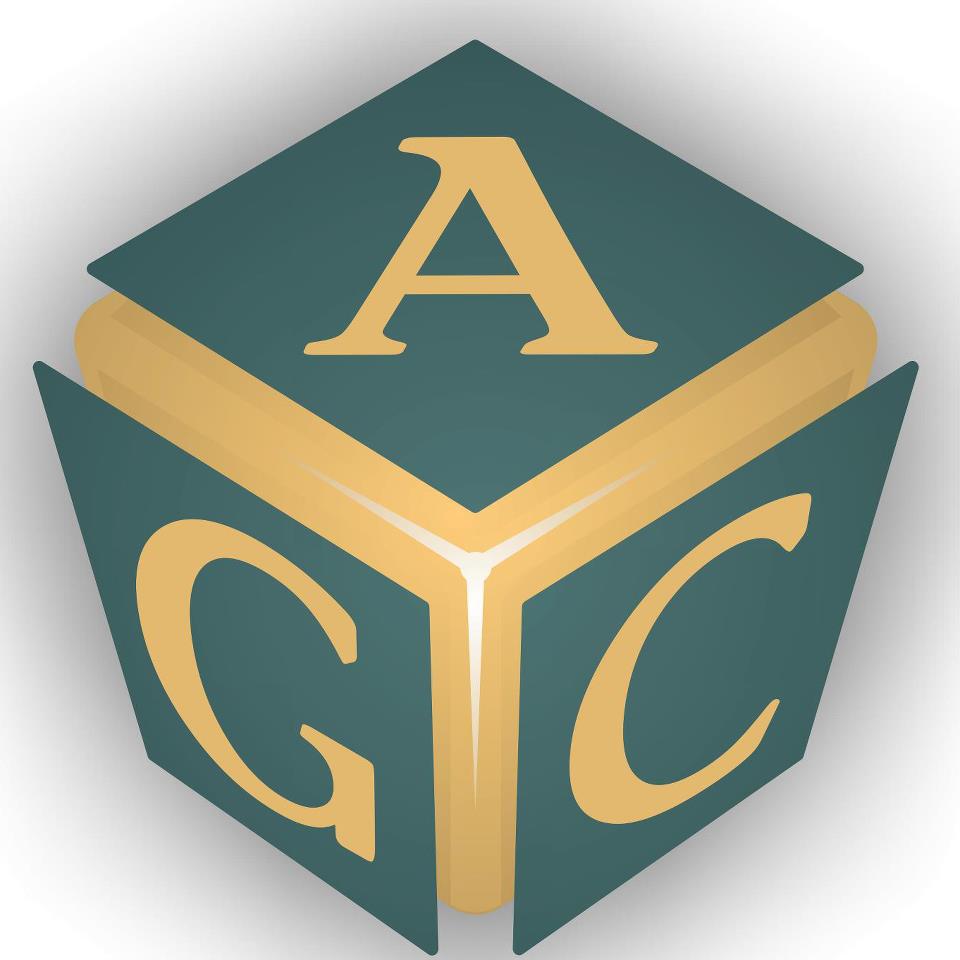
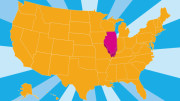
only interested in your own version of the ‘truth’ i see.
No, I decided that allowing an environment where poorly written drive by comments that are meant to be mean didn’t suit me or my mood. I fiqure if a person cannot at least stand by THEIR convictions with a name and a real email, then really, why should I afford that person the right to converse with my readers who also might desire to know the source of a conversation?
Or, as my daughter loves to say, “I do what I want.” And for once, I didn’t feel beholden to treat a nasty person with undeserved kindness and consideration.
And much of the adoption-related government-subsidized money goes to the Children’s Bureau of the Department of Health and Human Services. They in turn allocate money to the Congressional Coalition on Adoption in which many U.S. representatives and senators belong. This shows that adoption racketeering not only goes to the top but is engaged in by those in our country who never should be so involved! And obviously they all get money from their adoption involvement.